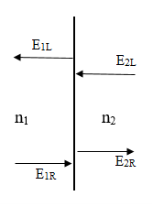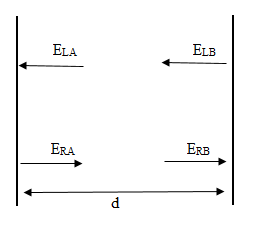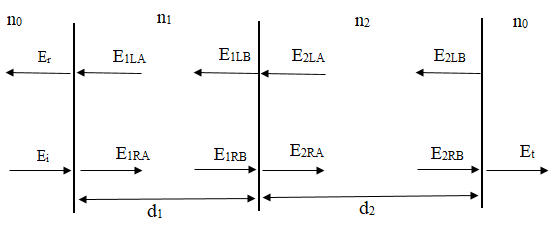In this article, describe analyzing optical properties of solar cells with mathematical approaches and using transfer matrix method and its advantages.
Key words: transfer, matrix, absorption, reflection, transmission
We theoretically analyze the reflection, absorption, and transmission coefficients of solar cells with an anti-reflective layer. The phenomena of light at the boundary of the environment are mainly determined by Fresnel laws. But what if it's in multiple layers, not on the border? How is it determined then? We use the transfer matrix method to do this.

Fig. 1. Electric field on surface
Here:
E1R, E2R are the electric field strengths to the right.
E1L, E2L are the electric field strengths to the left.
 (2)
(2)
We express that the electric field entering the surface by exiting the surface.
t1,2 and r1,2 are the transmission and reflection coefficients from medium 1 to medium 2. t2,1 and r2,1 are the transmission and reflection coefficients from medium 2 to medium 1.
We can determine these by Fresnel equations. The relationship between them is given in formulas 3 and 4. Due to the wave nature of light, electric and magnetic fields oscillate in a perpendicular plane and are classified relative to each other. This means that they are equal. To determine the properties of light in the mediums, we mainly use the electric field [1].
![]() (3)
(3)
![]() (4)
(4)
Now, if we add formulas 3 and 4 to formula 2, we get a connection between the 1st and 2nd mediums.
 (5)
(5)
 (6)
(6)
 (7)
(7)
D1,2 is called the transmission matrix. From this matrix we can express the change in the electric field at the boundary between the two media.

Fig. 2. Electric field at both ends of the medium
We know that electromagnetic waves are absorbed in the medium. In this way, we can find the relationship between the electric field at one end of the medium and the electric field at the other end [2].
![]()
 (8)
(8)
 (9)
(9)
 (10)
(10)
P is the term «propagation» matrix, which refers to the absorption of light into the medium.
d is the thickness of the medium.
k is the number of light waves in the medium.
i is an complex number.
We find the reflection, absorption, and transmission coefficients of a 2-layer system by using the matrix method.

Fig. 3. Electric fields in a 2-layer solar cell
If we use the matrix method.
 (11)
(11)
 (12)
(12)
 (13)
(13)
 (14)
(14)
 (15)
(15)
Here:
Ei is the incident light
Er is reflected light
Et is the light that passes through the body
If we substitute the above expressions one by one, we get the connection between the incident light, the reflected light, and the transmitted light.
 (16)
(16)
![]() (17)
(17)
 (18)
(18)
M is called the «transfer» matrix.
We know that light is divided into rays parallel to the plane of the screen and perpendicular to it. We have given the above expressions in general, if we want to calculate for parallel or perpendicular polarized rays, then we use the corresponding Fresnel formulas instead of r and t.
 (19)
(19)
 (20)
(20)
Using this method, we developed a program in C # 6.0 to determine the optical properties of solar cells.
References:
- A. Mahdjoub and L. Zighed. New designs for graded refractive index antireflection coatings. Thin Solid Films 478(1–2) (2005), pp. 299–304.
- S. A. Kovalenko, «Descartes-Snell law of refraction with absorption», Semiconductor Physics, Quantum Electronics and Optoelectronics, pp. 214–218, 2001.







